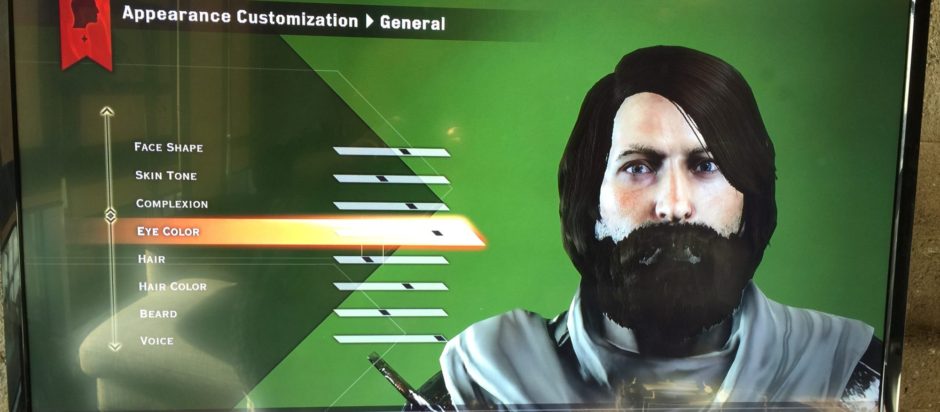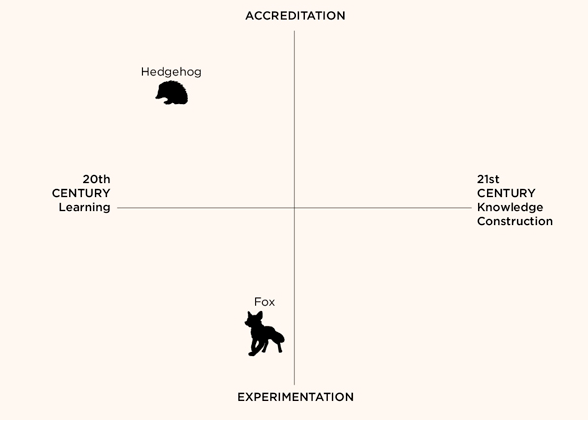An ecotone — literally, a place where ecologies are in tension — is a transitional area between different biomes, such as the boundary between grassland and forest or between different kinds of forests. Such places are sites for evolutionary dynamism, conflict, and experimentation. Ann Pendleton-Jullian, Director of the Knowlton School of Architecture at Ohio State University, draws on the ecotone as analogy and inspiration in her provocative essay regarding the future of design education and other institutional systems, Innovation Ecotones (.pdf).
Here, Pendleton-Jullian outlines the continuum between linear (“twentieth century”) and elastic/non-hierarchical (“twenty-first century”) learning and innovation models:
The left side of this continuum corresponds to models, methods, and mechanisms associated with twentieth century learning and the right side corresponds to how we are beginning to conceive of knowledge construction for the twenty-first century. A twentieth-century approach to education holds fast to the notion of teaching as a systematic delivery of knowledge—knowledge that is vetted and sanctioned and delivered in discipline-based packages from expert teachers to students. It is education in which one learns about specific stuff and how to do specific things.
In contrast, twenty-first century learning environments are about learning that extends far beyond the classroom (it scales), which in turn promotes elasticity and agency. The assumption is that we need to prepare for futures in which the specific things we will be doing, and specific stuff we will need to know, do not yet exist. Implicated in an education for the twenty-first century are all sorts of new mechanisms—cultural, social, and intellectual mechanisms—that are either directly or indirectly affiliated with the digital age as a global phenomenon.
Intuitively, we understand that a twenty-first century approach to learning is radically different from education that focuses on the accumulation of information and the simplistic transfer of culture and ideas associated with this information. But what is it more precisely? I would suggest that it begins with an epistemological shift in which learning how to learn and act (learning to be), in a highly situated manner, replaces learning about something. And then it is about how this scales, so as to create elasticity and agency.
Agency is the key word here. In the staid and siloed ecologies of traditional education, everyone has their place. Agency is reduced to choosing which silo you’re going to set yourself into — a choice which can drastically scale back your exposure to what’s going on in other silos. As a result, your world — your learning ecology — becomes smaller and less diverse over time. And the less diverse a given ecology becomes, the slower its pace of evolution and innovation.
In an “ecotone culture,” what once was siloed begins to collide, mix, and cross-pollinate, opening new vectors for discovery and collaboration. The results are unpredictable, but rich:
Because the students of the ecotone culture share the space and their work with others unlike themselves – with diverse species – there will be those cases in which one enters as one thing and evolves into something else: an architect, for instance, evolves into a musician/architect; or an astronomer evolves into an astronomer/environmentalist. Like the Greenbul [a bird whose song pitch and aeronautical capabilities adapt in response to its environment], though, it is not a change of song but a new tonality that honors both the song structure and the new context. This means that this new talent will acquire the ability to contribute in more than one field and maintain a key presence in multiple camps.
The ecotone analogy is extensive and highly productive. Diversity of species, new species development, keystone species as engineers, distribution of nutrients, corridors for transfer of creatures and stuff—even the idea of microhabitats (smaller habitats within larger habitats, like a tidal pool)—are all intensely relevant in terms of conceiving, designing, and implementing organizational structures and mechanisms for this innovation ecology model. Each component might independently have an impact and add value to the system, but the fact that the ecotone is a system, rather than a collection of components, means that their collective impact scale.
It should be noted that establishing an innovation ecotone in an institutional setting does not mean that one must completely change the entire system overnight. As I’ve observed over the past few months, a lightweight and entirely opt-in pervasive game geared around peer discovery and collaborative production can have transformative effects on an otherwise siloed educational environment. Once the channels for agency and disciplinary elasticity have been opened, it’s hard to close them again. After all, young media artists, theorists, and designers (among many others) are eager to find their niche in the world, to discover their identities, and to make a contribution — and in diversity, there is opportunity.
Download the complete text: Innovation Ecotones (.pdf)

